Apple's Bumper Case
The iPhone 4 is Apple's second product to launch with first party accessories. Like the iPad before it, the iPhone 4 is available with an Apple fabricated and sold case, dubbed the "bumper." At launch, this was the only case available. Most Apple stores (and online) only had black in inventory, though I'm told a few also had pink in stock. As of right now, the Apple store shows other colors shipping on July 16th - white, pink, orange, green, and blue eventually. I just went with black.
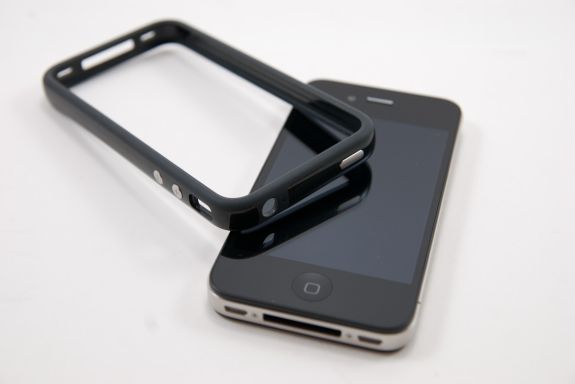
The bumper is an interesting beast. For $29.00, you get a hard plastic strip that runs atop the stainless steel antenna band, completely around the phone. On the outside of the hard plastic are two stiff rubber bands that seal over the side of the phone. If the Otterbox Defender is a bomb proof suit for iPhones, Apple's bumper is more like a slightly-scandalous bikini. It's literally just a continuous strip of material.
Apple brings the exterior metal volume and standby buttons out to the edge of the phone, and from what I can tell they're also metallic.
Buttons are metal and brought through the case, except the vibrate/silent switch.
Inside the case, there's a felt-like mask which rests atop the buttons and aligns itself up. It works surprisingly well, and the buttons feel like those on the device itself. There's no gap inbetween - hey, the buttons just work.
Putting it on is a little bit of a struggle. I've found the best way is to insert the top, standby button side first (so you don't accidentally turn it on and off while inserting it), and then shove the bottom part in. After you've got it in, there's just a bit of massaging to get the rubber seats settled, and then you're good to go. It's very snug, there's no flexing.
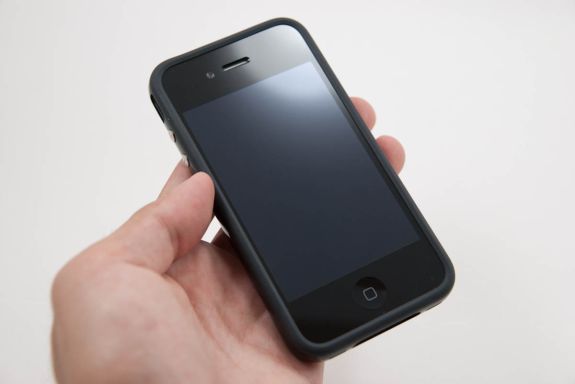
At the top, there's a break in the hard plastic for the headset jack. Instead, this is entirely rubber. No doubt this is to allow jacks that come out and have a 90 degree bend to be inserted, something we're all too familiar with being a problem on previous iDevices. There's a tiny hole next to it you want to be absolutely certain isn't blocked for the noise canceling microphone.
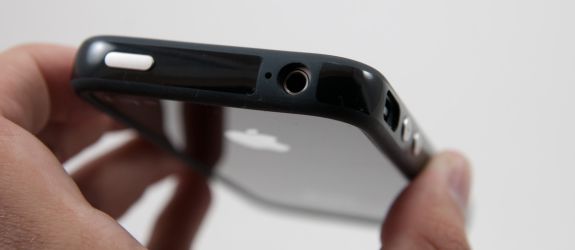
The nice thing about the rubberized strips is that you get a grippy surface to hold the phone with, and you raise the front and back glass panes about a millimeter off the surface you're resting it on when you lay it down flat.
The idea of having a glass back is fine and dandy until you lay the iPhone on another glass surface directly. The result (if both surfaces are very clean) is that the two will come in optical contact and become very hard to pry apart. It's the same sort of reason coasters aren't glass - the two seal together, and become difficult to separate. Not to mention any particulates underneath will make those hairline scratches (sleeks) I talked about before. Even the strongest of glasses will get micro scratches when rubbed in optical contact with other glasses. It's obvious that raising both the front and back were design objectives here.
Look ma, I can rest the phone face down and not scratch it up!
Apple's bumper case is unique that it doesn't cover the back of the phone. At all. If you prefer a case that covers every square inch of the device and offers total protection, don't get the bumper and instead wait for something else. If you want to show off as much of the iPhone 4's design as possible, Apple has done it with the bumper. If you already purchased an iPhone 4, well, you know that outside of a plastic bag or a rubber band, the bumper is really the only option.
Like we talked about before, the other hugely notable benefit is that the bumper insulates the stainless steel band from being detuned by your meatbag extremities (read: hands). Instead of a 24 dB drop, you'll incur a 10 dB drop completely in line with every other cellular phone ever made.
The only problem with the bumper is the dock connector port. It's about a millimeter too small.
That doesn't fit inside. Frustrating? Yes.
The unfortunate result is that all of my third party accessories don't fit. My Alpine iDA-X001 head unit in the car, three different vehicle accessory port car chargers with dock connectors, all my third party cables, and not to mention docks all don't fit.
If you've rolled with other cases, this is an all too familiar story that seems to repeat every single release, but it's frustrating in this case because the connectors don't match up by seriously under a millimeter. You can jam the dock connector in, but it doesn't go far enough inside to snap into place, and comes right back out.
The result is that I drive around with the bumper case halfway off, like this:
It's not the end of the world, but I would have to file down that edge a half millimeter on both sides to make my accessories work again. Considering just how much the bumper improves signal and protects against accidental scratching, it's arguably a must have accessory. One that should maybe be given away with every iPhone 4 purchase. But you already know our thoughts on that.
No doubt within a month or two the usual assortment of iPhone cases will pop up again, tweaked to meet the iPhone 4's slightly thinner dimensions. For now, however, the bumper is essential.



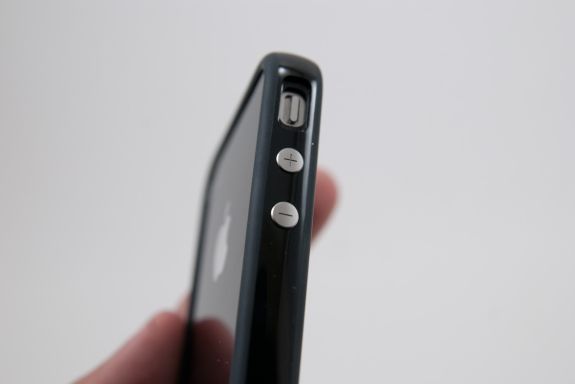


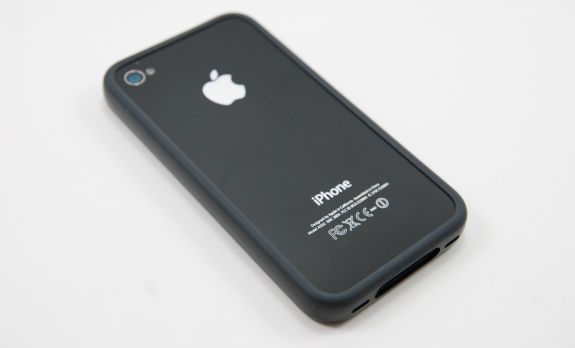
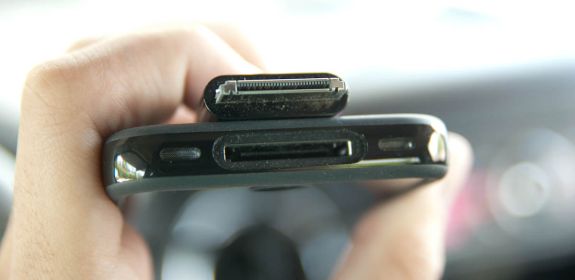
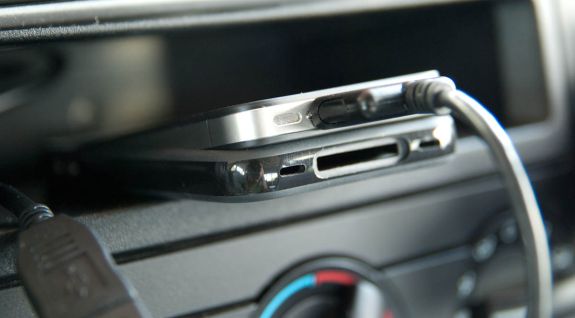








270 Comments
View All Comments
JAS - Wednesday, June 30, 2010 - link
AT&T recently upgraded its 3G network in New York City. So, the improved wireless connection experienced with the iPhone 4 might be coincidental.http://news.cnet.com/8301-1035_3-20009134-94.html
John Sawyer - Thursday, July 1, 2010 - link
You mean, "might NOT be coincidental"?John Sawyer - Thursday, July 1, 2010 - link
A very large part of the problem between ATT and the iPhone prior to model 4, has been a weird interaction between the two, rather than being due to just one or the other. I don't know which party is more to "blame" for not having addressed this problem, but since the iPhone 4, and non-iPhones, experience much fewer problems with ATT's signal, I suspect Apple and the previous iPhone designs are more to blame, and ATT has allowed itself to take the brunt of it.Dennis Travis - Wednesday, June 30, 2010 - link
Another Outstanding review. So much detail. The part on the Antenna was great. Answered any questions I had about the iPhone 4.Thanks so much.
mongo lloyd - Wednesday, June 30, 2010 - link
"If you're married to Android, in the next 6 - 12 months we should see feature parity from the competition."I must be mad then, because I'd say there are Android smartphones out there that match, or even surpass the iPhone 4's features (especially software-wise), apart from battery life and the high-res screen (but the difference isn't massive between 600x960 and 480x800 or 480x854, plus you have the TFT vs (S)AMOLED pros and cons).
mongo lloyd - Wednesday, June 30, 2010 - link
It is a nice screen though, I must say.solipsism - Wednesday, June 30, 2010 - link
Buying and using nearly every new smartphone I can't say that Android beats iOS in any consumer way expect for the anemic notification system found on iOS, but while Android is pretty decent, it's still a far cry from WebOS. I haven't gotten the push for Froyo yet, have they finally fixed copy/paste on Android to?I see Android (and other) smartphones being in trouble in this next year against the iPhone 4. They will need to compete against the iPhone 4's display but at the risk of battery life, which they already do poorly in (despite the iPhone getting a bad rap). Unless Froyo has brought about some dynamic power management changes I don't think see other smartphones being as competitive as they would have been otherwise.
Spoelie - Wednesday, June 30, 2010 - link
In GSMarena's preview of iOS4, there is a whole list of features that iOS4 does not do that Android does. This is not a stab at iOS4, but it does validate the conclusions Anand makes and it proves that you can't really make blanket statements like "can't say that Android beats iOS in any consumer way". It just depends how much you value those kind of features. The list reads like this:* No Flash support in the web browser
* No true multitasking for all applications
* iOS4 for iPhone 3G has limited new feature set
* Poor performance on iPhone 3G
* No quick toggles for Wi-Fi, Bluetooth or 3G
* No social networking integration
* No info widgets on lockscreen or homescreen
* SMS tones are still not customizable
* No mass mark emails as read
* No proper file browser or access to the file system
* No USB mass storage mode
* No vibration feedback when touching the screen
* No Bluetooth file transfers to other mobile phones
* Contacts lack a swipe-to-delete or mass delete feature
* No SMS/MMS delivery notifications
* No smart dialing (but Spotlight is a somewhat of a substitute)
* No DivX or XviD video support and no official third-party application to play that
* The whole iPhone is too dependent on iTunes - you cannot add the same type of content (video, photos, apps) to the phone from two computers, a regular file management interface would have been much better
Again, not a stab at iOS4, just to point out the different markets.
FATCamaro - Wednesday, June 30, 2010 - link
I think all but 3 in your list are design choices rather than missing features. The only things that seem like features would be...* No info widgets on lockscreen or homescreen
* No SMS/MMS delivery notifications
* No mass mark emails as read
Griswold - Wednesday, June 30, 2010 - link
Theres no difference for the enduser between design choices and missing features - if it doesnt do what you want or need it to do, its not the right phone. That said, the feature set of android is much richer, but not everyone wants or needs that... apparently. Doesnt change the fact that android does beat iOs in many ways.